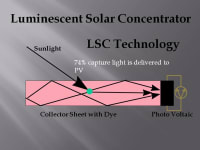Passive luminescent solar concentrators (LSC) are possible that have high efficacy, long life and low cost. Luminescent solar concentrators consist of a fluorescent dye in a transparent matrix that captures and concentrates light. The most efficiency design is a flat sheet end coupled with what can use the concentrated light.
LSCs can be coupled to photovoltaic (PV) cells to benefit from:
• reducing the cost of a PV power panel by about half
• concentrating sun light 3-30 times before delivering it to a PV cell
• collecting available light and concentrating about 75% of collected light to a PV cell
• collects light independent of the collector’s angle to the sun making this technology favorable for marginal light markets
• being easily integrated into buildings with a wide range of aesthetic options
Technology Evolution - Current PV power generation with polycrystalline silicon cells is relatively mature, and technology evolution will most likely occur within the supporting subsystems to significantly alter the marketplace. LSC advances an optic subsystem to improve the acquisition and management of light and allow low cost installation techniques. Ultimately LSC can lower cost per watt produced to enhance widespread adoption of PV solar power.
LSCs have been used in nature for about 750,000 years to concentrate light energy to a reaction center. The LSCs we are proposing are plastic analogs of how light is collected and concentrated in green plants. The LSC were originally invented in the 1970, but were not practical. High efficiency LSC systems photo-bleach in a matter of months. Alternatively, very stable dyes have low capture efficiency. This technology is especially useful for high efficiency, but higher cost PV cells such as gallium arsenide or crystalline silicon cells. The LSCs are just as efficient with diffuse light as with direct spectral sun light. For this reason they are exceptionally useful for cloudy or extreme latitude/ solar installations.
Technical Breakthrough- Recently, we developed technology to increase the life of the high efficiency dyes to 15 year or more. The high efficiency dyes photobleach from an excited triplet state. By tailoring a triplet state quencher and conjugating it to the dye, the dye photo-lifetime is increased by more than an order of magnitude. A provisional patent application has been filed to protect the method and application.
Target Market- Initially, the market targets are applications where the increased diffuse light performance and lower cost are desired. As technology is proven and accepted it will advance to more general markets. Because the LSCs are made of colored plastic, they are very amenable to building integrated PV. Conventional looking roofing and building siding are likely secondary targets.
Business Model - We will produce and sell LSC inserts to manufacturers of completed solar panels. We will also license technology to manufactures of completed solar panels and plastic sheet stock. There are many well established firms making dyed, UV stable, optical grade plastic who can contract manufacture with our specific dye and dye protecting chemistry.
Voting
-
ABOUT THE ENTRANT
- Name:Reed Shick
- Type of entry:individual
- Profession:
- Number of times previously entering contest:never
- For managing CAD data Reed's company uses:None
- Reed's hobbies and activities:entrepreneurship, boating, fishing
- Reed belongs to these online communities:Conctrated Photovoltaic,
- Reed is inspired by:Most ideas for technical advancement are already in existence in other industries or in nature. I look to apply well known solutions from other fields into the technology I am currently working.
- Patent status:pending





